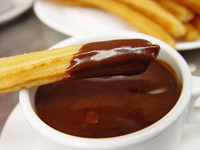

Desserts and sweetmeats are also among some of the most famous elements of the Spanish cuisine tradition. Recipes are passed from generation to generation of women (though nowadays sons ask their mothers for the recipes to!). Each Spanish family has its own favorite dessert, and Spaniards may argue forever about who makes it better.
Like many Spanish dishes, lots desserts have Moorish influence, especially since they were the first to cultivate and consume almonds and honey, two of the main ingredients in a number of Spanish desserts.
But without nuns, many desserts wouldn't exist, specially those without animal products (remember that any meat save for fish is forbidden during Lent). For centuries cloister nuns have made cakes, cookies and other delicacies to sell and it has even been their secondary source of income.
Little is known about the dessert made in Spain before the arrival of the Romans. It is thought that they may have made cakes with honey in these times, honey being a traditional sweetening product. Therefore Spanish dessert making really took off when the Romans came to the Iberian peninsular. The Romans brought several new techniques for sweetening dishes such as using wine syrup as well as honey. In these times, there were a lot sweet breads and pastries made in Spain.
The Moors also helped to develop Spanish sweets and puddings by bringing sugarcane to the country. There are records of sugarcane being refined by the Moors during the 9th century. This revolutionary new substance helped to develop Spanish cakes in particular. Almonds too began to be used under the Moorish occupation of Spain which would later lead to some of the most characteristic items of Spanish gastronomy such as marzipan.
With the mixture of religions in Spain - Christian, Jews, and Muslims living together - lead to a rise in desserts created for religious reasons. Jewish desserts from these times that still survive today include roscas which were commonly eaten for the Jewish celebration of Sukkot, or the Feast of Tabernacles. However, after the reconquista and the expulsion of the other two religions, it was the Christians who took over the dessert sector in Spain. For many centuries afterwards, the inventions of desserts came mostly from within the walls of convents. Today, many of these desserts are still made by nuns and have particularly strong association with Christian festivals such as Easter and Christmas.
With the discovery of the Americas, even more ingredients made it into the Spanish gastronomy; among them was chocolate. This particular ingredient didn't make a huge impression on some of the existing desserts in Spain, however it was combined with churros to make the ever famous, Madrileñan favourite of chocolate con churros. Other important ingredients used in Spanish desserts to come from the New World include cinnamon, vanilla and coffee. In fact, a lot of the desserts we know today would not have existed if it hadn't been from the Spanish conquest of South America.
Today, many of these desserts are only consumed on special occasions such as Christmas and Easter, and few people make them at home. You can still find old convents that make some of these desserts, who use the money as a secondary income. However it seems a shame that these sweets should be lost - so why don't you try and make some yourself. If you follow the links at the bottom of the page, you can find out more about the history of some of the favourite Spanish desserts, as well as find a simple and easy recipe for you to try at home.
So don't be shy about it, taste as many of this heavenly sweet creations, you won't regret it!